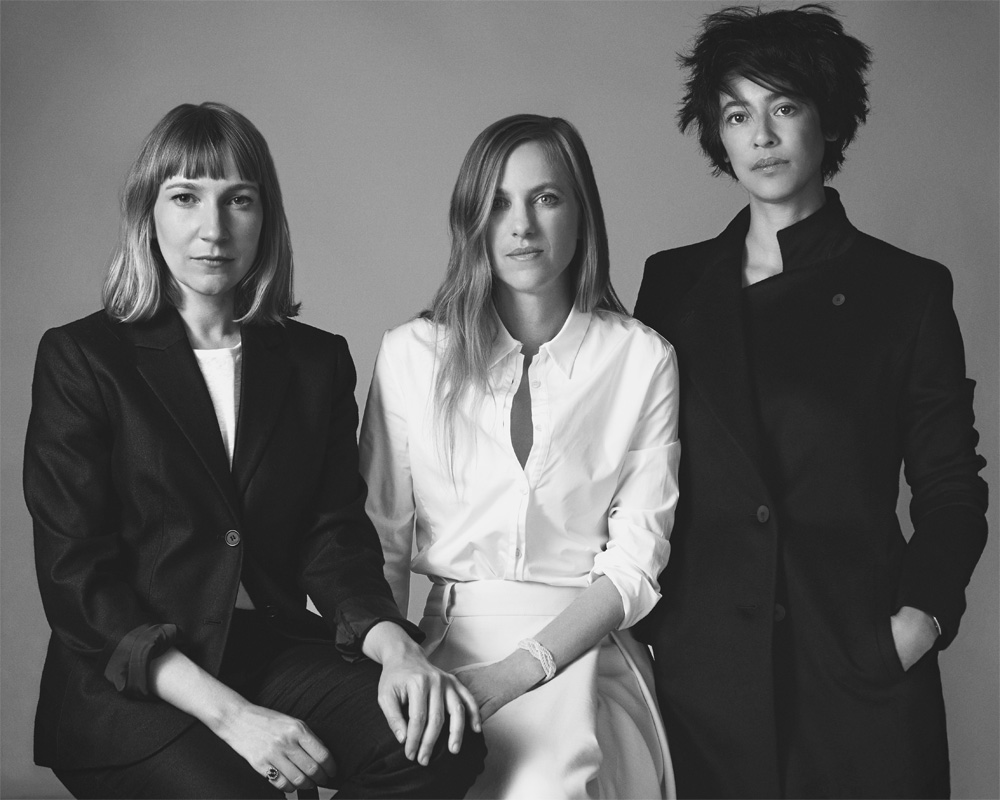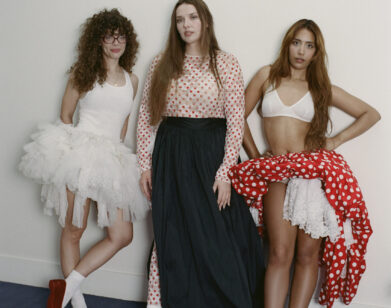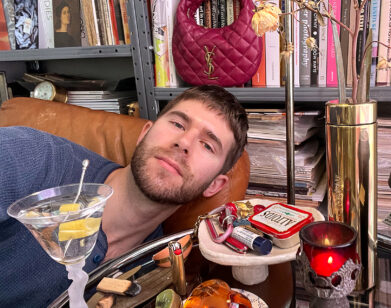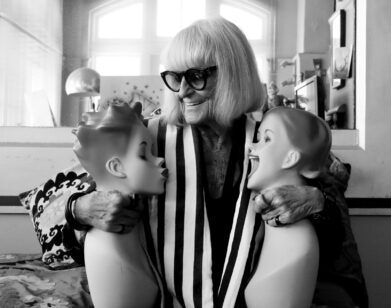Sheila Heti, Heidi Julavits, Leanne Shapton

ABOVE: SHEILA HETI, HEIDI JULAVITS, AND LEANNE SHAPTON IN NEW YORK, JUNE 2014. ON HETI: SUIT: JIL SANDER. T-SHIRT: ALEXANDER WANG. ON JULAVITS: SHIRT AND SKIRT: HERMÈS. ON SHAPTON: COAT: HUGO BOSS BLACK. STYLING: CATHERINE NEWELL-HANSON.
“Clothes make the man,” wrote Mark Twain, “Naked people have little or no influence on society.” It would seem that authors Sheila Heti, Heidi Julavits, and Leanne Shapton are in agreement. In their 500-page cabinet of sartorial curiosities, Women in Clothes, out this month from Blue Rider Press, the three women (with the help of a mere 639 contributors) leave no hem unturned while exploring how women dress themselves and why. The book is a thoughtful, droll, and often moving tome meant to be dipped in and out of (they each answered my question of where to keep this book with “the bathroom”). One visit with Women in Clothes brings a photographic display of bobby pins, illustrations of clothing stains, forensic maps of clothing on the floor, a practical survey on breasts, Tavi Gevinson on colors, a personal essay from the enchanting writer Elif Batuman, and a conversation between Molly Ringwald and Cindy Sherman. A second visit reveals interviews with writer Leopoldine Core, a photography project curated by Miranda July, socialite and former model Lucy Birley’s stories about a young Alexander McQueen, odes to lost clothes, lessons from a “declutter coach,” photographs of hands and the stories of the rings that adorn them, transcripts of compliments paid to strangers, and straightforward gems such as this one from writer Roxane Gay: “Rompers are not ever going to be on my body.”
Like a fashionable mercury spill, the idea for the book began with Heti and absorbed her fellow novelists Julavits and Shapton along the way. “The main problem I’ve always had with fashion media,” Heti writes in the introduction, “is that women are encouraged to copy other women.” So she sent an incredibly in-depth questionnaire to hundreds of women with questions ranging from “What are you trying to achieve when you dress?” to “Tell us about something in your closet that you keep but never wear.” The results are amusing, enlightening, and often startlingly honest. Like this one from a woman named Alesia Pullins: “Sometimes I feel like no matter how I present myself, I look threatening. I think it’s just because I am a black woman. So sometimes I’ll want to dress to seem more approachable. Like for job interviews or meetings, I tend to wear lighter colors, even though I don’t really feel it in my soul.”
In fact, the most moving parts of the book go “beyond our circle of friends and our circle of friend’s friends,” as Heti puts it. “We wanted to encompass more of the world than just what we could reach by extending our arms.” This includes a fascinating firsthand account of a Cambodian garment worker making bras for an international brand (“While working, I hold the bra up in front of my face, then I ask myself, ‘Who is the woman who will wear the bra I am sewing?’ ”) and the powerful story of a teenage girl who survived the 2013 Rana Plaza collapse in Bangladesh. Due to the formidable size and breadth of Women in Clothes, these topical switches are never jarring (as they sometimes can be in women’s magazines that jump from scents to Syria).
“Talking about clothing is a fruitful story trigger,” says Julavits. “This book was an incredible excuse to say to a person I’d literally met two minutes earlier, and who seemed to have an interesting life or history, ‘Can I interview you about clothing?’ ”
In the end, immersing themselves in this stylish Rashomon about the intentionality of dress also changed the authors’ own wardrobe philosophies. Julavits told me that she was wearing “a striped T-shirt Leanne just gave me” while she answered my questions. (“I like giving clothes I don’t wear very often to friends,” says Shapton. “It’s like matchmaking two people you like, with so much less at stake.”) “Before doing this book,” Julavits explains, “I think I believed that, from a style and grooming perspective, I had yet to ‘grow up,’ that I was not properly ‘a woman,’ or some such notion of inadequacy. I no longer feel that way. The book enabled me to inhabit my stylistic predilections more deeply and without feeling like a failure.” Perhaps Women and Clothes is the pulchritudinous addendum to Mr. Twain’s famous quote—clothes make the woman.
COSMETICS: CK ONE, INCLUDING 3-IN-1 FACE MAKEUP SPF 8, MASCARA, AND POWDER EYESHADOW QUAD. HAIR PRODUCTS: BUMBLE AND BUMBLE INCLUDING STYLING LOTION. HAIR: LAURA DE LEON FOR JOE MANAGEMENT. MAKEUP: CYNDLE KOMAROVSKI/BRYDGES MACKINNEY. SPECIAL THANKS: FAST ASHLEYS.






